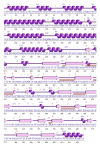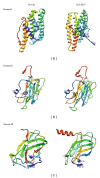In silico modeling and functional interpretations of Cry1Ab15 toxin from Bacillus thuringiensis BtB-Hm-16
- PMID: 24228249
- PMCID: PMC3818814
- DOI: 10.1155/2013/471636
In silico modeling and functional interpretations of Cry1Ab15 toxin from Bacillus thuringiensis BtB-Hm-16
Abstract
The theoretical homology based structural model of Cry1Ab15 δ-endotoxin produced by Bacillus thuringiensis BtB-Hm-16 was predicted using the Cry1Aa template (resolution 2.25 Å). The Cry1Ab15 resembles the template structure by sharing a common three-domain extending conformation structure responsible for pore-forming and specificity determination. The novel structural differences found are the presence of β0 and α3, and the absence of α7b, β1a, α10a, α10b, β12, and α11a while α9 is located spatially downstream. Validation by SUPERPOSE and with the use of PROCHECK program showed folding of 98% of modeled residues in a favourable and stable orientation with a total energy Z-score of -6.56; the constructed model has an RMSD of only 1.15 Å. These increments of 3D structure information will be helpful in the design of domain swapping experiments aimed at improving toxicity and will help in elucidating the common mechanism of toxin action.
Figures







Similar articles
-
The theoretical 3D structure of Bacillus thuringiensis Cry5Ba.J Mol Model. 2008 Sep;14(9):843-8. doi: 10.1007/s00894-008-0318-8. Epub 2008 May 27. J Mol Model. 2008. PMID: 18504623
-
The theoretical three-dimensional structure of Bacillus thuringiensis Cry5Aa and its biological implications.Protein J. 2009 Feb;28(2):104-10. doi: 10.1007/s10930-009-9169-0. Protein J. 2009. PMID: 19191014
-
Computational tridimensional protein modeling of Cry1Ab19 toxin from Bacillus thuringiensis BtX-2.J Microbiol Biotechnol. 2012 Jun;22(6):788-92. doi: 10.4014/jmb.1106.06034. J Microbiol Biotechnol. 2012. PMID: 22573155
-
Phylogenetic relationships of Bacillus thuringiensis delta-endotoxin family proteins and their functional domains.J Bacteriol. 1997 May;179(9):2793-801. doi: 10.1128/jb.179.9.2793-2801.1997. J Bacteriol. 1997. PMID: 9139891 Free PMC article. Review. No abstract available.
-
Cyt toxins produced by Bacillus thuringiensis: a protein fold conserved in several pathogenic microorganisms.Peptides. 2013 Mar;41:87-93. doi: 10.1016/j.peptides.2012.05.023. Epub 2012 Jun 9. Peptides. 2013. PMID: 22691603 Review.
Cited by
-
Structural comparison, substrate specificity, and inhibitor binding of AGPase small subunit from monocot and dicot: present insight and future potential.Biomed Res Int. 2014;2014:583606. doi: 10.1155/2014/583606. Epub 2014 Sep 2. Biomed Res Int. 2014. PMID: 25276800 Free PMC article.
References
-
- Roh JY, Choi JY, Li MS, Jin BR, Je YH. Bacillus thuringiensis as a specific, safe, and effective tool for insect pest control. Journal of Microbiology and Biotechnology. 2007;17(4):547–559. - PubMed
-
- Hofmann C, Vanderbruggen H, Hofte H, van Rie J, Jansens S, van Mellaert H. Specificity of Bacillus thuringiensisδ-endotoxins is correlated with the presence of high-affinity binding sites in the brush border membrane of target insect midguts. Proceedings of the National Academy of Sciences of the United States of America. 1988;85(21):7844–7848. - PMC - PubMed
-
- Boonserm P, Davis P, Ellar DJ, Li J. Crystal structure of the mosquito-larvicidal toxin Cry4Ba and its biological implications. Journal of Molecular Biology. 2005;348(2):363–382. - PubMed
-
- Derbyshire DJ, Ellar DJ, Li J. Crystallization of the Bacillus thuringiensis toxin Cry1Ac and its complex with the receptor ligand N-acetyl-D-galactosamine. Acta Crystallographica D. 2001;57(12):1938–1944. - PubMed
Publication types
MeSH terms
Substances
LinkOut - more resources
Full Text Sources
Other Literature Sources

